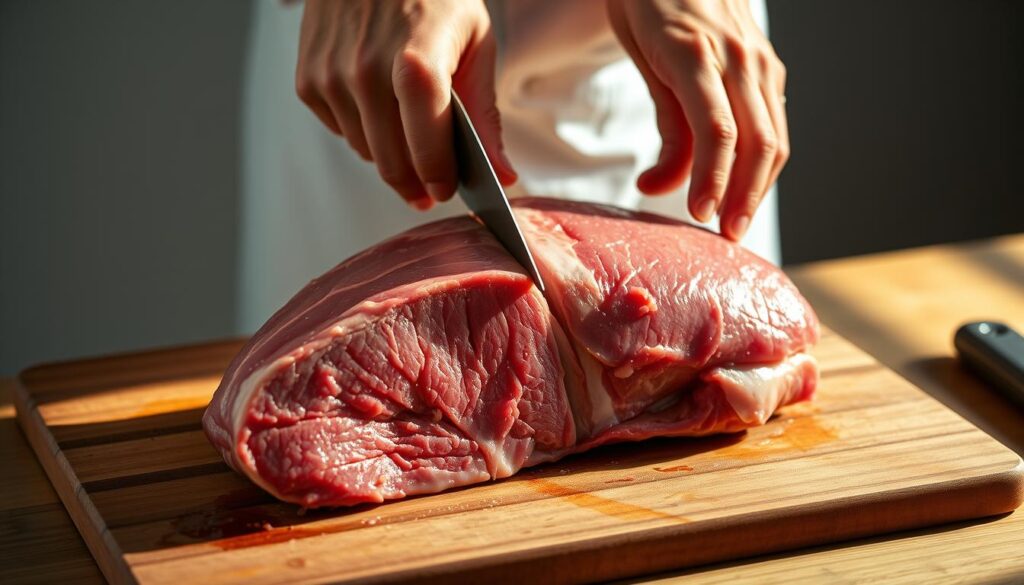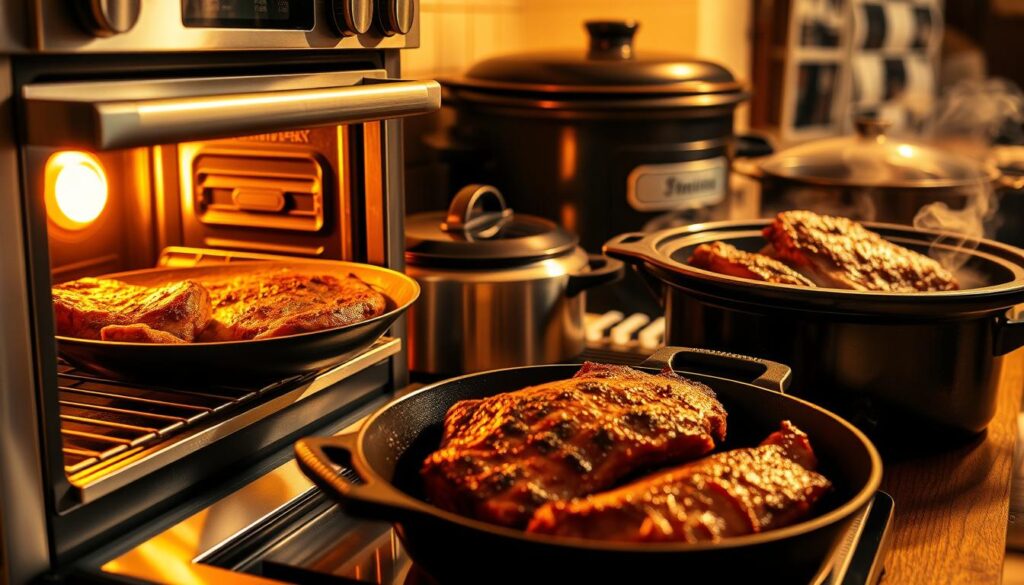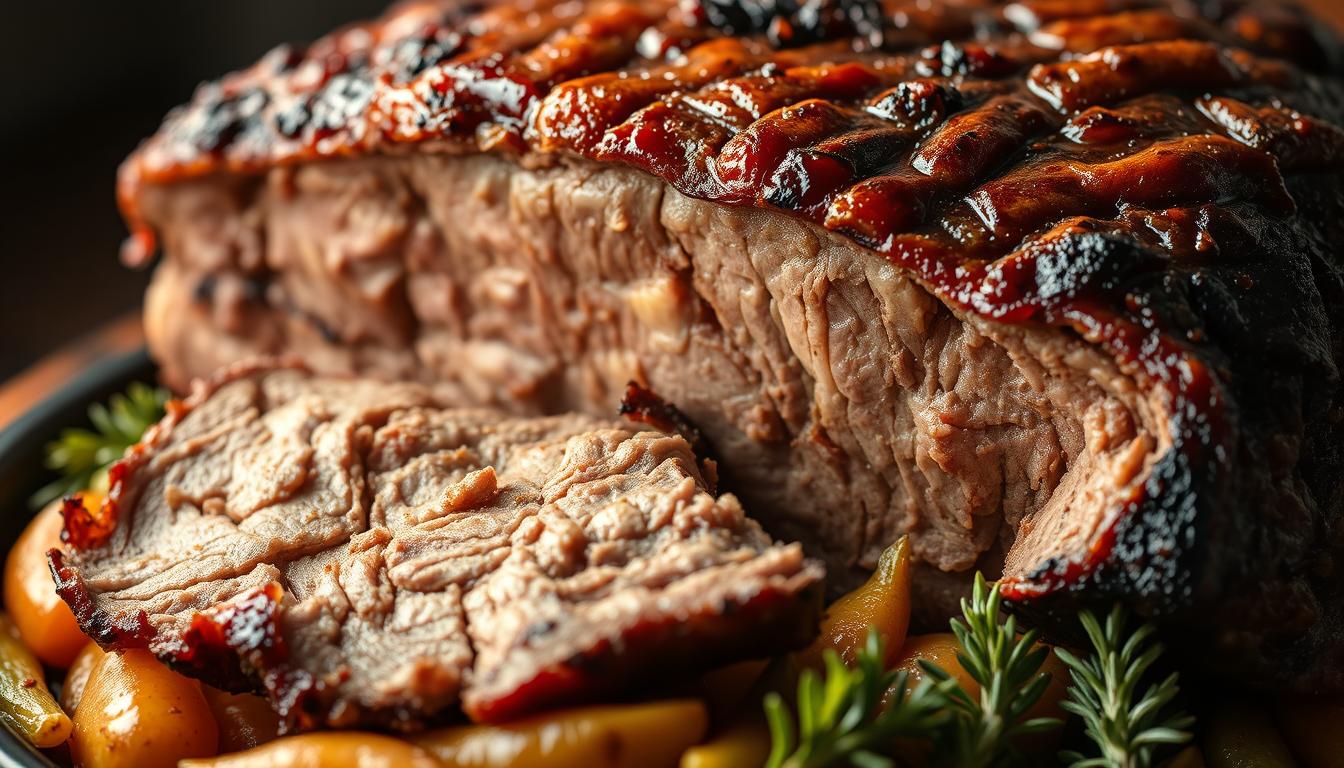Imagine sinking your teeth into tender, flavorful beef brisket, perfectly cooked to fall-apart texture. The aroma of slow-cooked meat wafts through your home, tantalizing your taste buds and building anticipation for a truly satisfying meal.
You can achieve this mouthwatering dish in the comfort of your own kitchen with a simple oven-cooked beef brisket recipe. By slow cooking the brisket in the oven with a blend of spices and sauces, you’ll create a truly unforgettable culinary experience.
Table of Contents
ToggleKey Takeaways
- A tender and flavorful dish perfect for special occasions or everyday meals.
- Slow cooking in the oven ensures a fall-apart texture.
- A blend of spices and sauces enhances the natural flavor of the brisket.
- Easy to prepare with a simple recipe.
- Perfect for impressing family and friends with a delicious meal.
Understanding Beef Brisket: The Perfect Cut for Slow Cooking
The beef brisket, a cut often misunderstood, reveals its true potential when subjected to slow cooking methods. This tougher cut of meat becomes tender and flavorful with the right cooking techniques.
What Makes Brisket Special
Beef brisket is special due to its unique composition. It contains a significant amount of connective tissue, which, when broken down through slow cooking, results in a tender and juicy texture. The brisket’s fat cap also contributes to its flavor and tenderness.
Different Cuts of Brisket Explained
There are primarily two cuts of brisket: the flat cut and the point cut. The flat cut is leaner and more uniform, making it easier to slice. The point cut, on the other hand, is fattier and more flavorful. Understanding these cuts is crucial for selecting the right brisket for your recipe.
When choosing a brisket, consider the occasion and your personal preferences. For a more tender and easier-to-slice brisket, the flat cut might be preferable. For a richer, more intense flavor, the point cut is an excellent choice.
Selecting the Perfect Brisket for Your Recipe
A great oven-cooked brisket begins with choosing a high-quality brisket that meets your recipe’s needs. The right brisket can make all the difference in achieving tender, flavorful meat.
Size and Quality Considerations
When selecting a brisket, consider the size of your gathering and the cooking method. A larger brisket is ideal for bigger groups, while a smaller one suffices for intimate gatherings. Look for a brisket with a good balance of fat and meat, as this will enhance the flavor and tenderness.
Quality is also paramount. Opt for a brisket with a thick, even fat cap, as this will help keep the meat moist during cooking. The meat itself should be a deep red color, indicating good marbling and potential for tender results.
Grass-Fed vs. Grain-Fed Brisket
The diet of the cattle can significantly impact the flavor and characteristics of your brisket. Grass-fed briskets tend to have a leaner profile and a more robust, beefy flavor. They can be slightly tougher but offer a more nuanced taste experience.
Grain-fed briskets, on the other hand, are often fattier, which can result in a more tender and juicy final product. The flavor is typically milder compared to grass-fed briskets. Your choice between grass-fed and grain-fed brisket should be based on your personal preference and the specific requirements of your recipe.
Essential Equipment for Perfect Oven Cooked Beef Brisket
To cook a brisket to perfection in the oven, certain equipment is indispensable. The right tools not only make the cooking process easier but also ensure that your brisket turns out tender and flavorful.
Roasting Pans and Dutch Ovens
A roasting pan is a must-have for cooking brisket in the oven. It allows for even heat distribution and can accommodate the brisket comfortably. A Dutch oven is another excellent option as it retains heat well and can be used for slow cooking, resulting in a tender brisket.
Thermometers and Other Helpful Tools
A thermometer is crucial for ensuring that your brisket reaches a safe internal temperature. Other helpful tools include a sharp knife for trimming the fat cap and a cutting board for slicing the brisket against the grain.
| Equipment | Purpose |
|---|---|
| Roasting Pan | Even heat distribution |
| Dutch Oven | Slow cooking and heat retention |
| Thermometer | Monitoring internal temperature |
Preparing Your Brisket Before Cooking
The key to a tender brisket recipe lies in the preparation steps you take before cooking. Proper preparation enhances the tenderness and flavor of the brisket, making it a mouthwatering dish.
Trimming the Fat Cap
Trimming the fat cap is an essential step in preparing your brisket. Leaving about 1/4 inch of fat helps to keep the meat moist during cooking. Use a sharp knife to carefully trim excess fat, creating an even layer. As noted by BBQ experts, “A well-trimmed brisket cooks more evenly and has better texture.”

Dry Brining Techniques
Dry brining, or pre-salting, is a technique that enhances the flavor and tenderness of the brisket. To dry brine, rub kosher salt and other seasonings onto the brisket, letting it sit in the refrigerator for a few hours or overnight. This process helps to lock in moisture and add depth to the meat.
Creating the Perfect Rub
A flavorful rub is crucial for a delicious brisket. Mix together your preferred spices, herbs, and other ingredients to create a rub that complements the natural flavor of the brisket. Apply the rub evenly, making sure to coat all surfaces. As
“A good rub is like a good handshake – it sets the tone for the whole meal.”
noted by a renowned pitmaster.
By following these preparation steps, you’ll be well on your way to creating a tender and flavorful brisket that’s sure to impress. Remember, the key is in the details: trimming the fat cap, dry brining, and applying a perfect rub all contribute to a mouthwatering oven-cooked beef brisket.
The Ultimate Oven Cooked Beef Brisket Recipe
Get ready to elevate your barbecue game with our ultimate guide to cooking the perfect beef brisket in the oven. This recipe combines the rich flavors of spices, BBQ sauce, and liquid smoke, slow-cooked to tender perfection.
Ingredients List
To create this mouthwatering dish, you’ll need the following ingredients:
- 1 whole beef brisket (about 5-7 pounds)
- 1/4 cup of your favorite dry rub
- 1/4 cup of BBQ sauce
- 2 tablespoons of liquid smoke
- 1 tablespoon of brown sugar
- 1 teaspoon of smoked paprika
- 1 teaspoon of garlic powder
- 1 teaspoon of onion powder
- Salt and pepper, to taste
Step-by-Step Cooking Instructions
Follow these steps to achieve tender, flavorful brisket:
- Preheat your oven to 300°F (150°C).
- Trim the fat cap on your brisket to about 1/4 inch.
- Apply the dry rub evenly across the brisket, making sure to coat all surfaces.
- Place the brisket in a large Dutch oven or a heavy-duty roasting pan, fat side up.
- In a small bowl, mix together the BBQ sauce, liquid smoke, brown sugar, smoked paprika, garlic powder, and onion powder. Pour this mixture over the brisket.
- Cover the pan tightly with aluminum foil or a lid.
- Place the brisket in the oven and cook for about 3-4 hours, or until it reaches an internal temperature of 160°F (71°C).
- Remove the brisket from the oven and let it rest for 15-20 minutes before slicing.
Internal Temperature Guide
Monitoring the internal temperature is crucial for achieving tender brisket. Use a meat thermometer to check the temperature. The ideal internal temperature for cooked brisket is between 160°F (71°C) and 170°F (77°C). For a more tender brisket, you can cook it to an internal temperature of 180°F (82°C) to 190°F (88°C), but be cautious not to overcook.
Tip: Letting the brisket rest after cooking allows the juices to redistribute, making the brisket even more tender and flavorful.
Mastering Different Cooking Methods for Brisket
The art of cooking brisket lies in choosing the right method to achieve tender, flavorful results. Brisket, a tougher cut of meat, becomes deliciously tender with the right cooking technique. Various methods can be employed, each yielding different results in terms of tenderness and flavor.
Low and Slow Method
Cooking brisket low and slow is a popular technique that involves cooking the meat at a low temperature for a long period. This method breaks down the connective tissues, resulting in tender, fall-apart brisket. It’s ideal for those who have the patience to wait for a truly tender product. The low and slow method is perfect for achieving a slow-cooked brisket that’s full of flavor.
Hot and Fast Technique
On the other end of the spectrum is the hot and fast method, where brisket is cooked at a higher temperature for a shorter duration. This technique requires precision to avoid overcooking, but it can yield a deliciously caramelized crust on the outside while keeping the inside juicy. The hot and fast technique is a great way to achieve a nicely cooked brisket when time is limited.
Wrapped vs. Unwrapped Cooking
Whether to cook brisket wrapped or unwrapped is another consideration. Wrapping brisket, often in foil, can help retain moisture and promote tenderization. However, cooking it unwrapped can lead to a nicer bark formation on the brisket’s surface. The choice depends on personal preference and the desired outcome. Some pitmasters prefer a combination of both methods for optimal results.

Sauces and Flavor Enhancements for Your Brisket
To create a truly unforgettable brisket, it’s essential to explore the world of sauces and flavor enhancements. These additions can elevate your dish from good to great, adding depth and complexity that will leave your guests wanting more.
Traditional BBQ Sauces
Traditional BBQ sauces are a staple in many brisket recipes. They add a tangy, sweet, and smoky flavor that complements the rich taste of the brisket. You can choose from a variety of BBQ sauce styles, such as Kansas City-style, Texas-style, or Carolina-style, each with its unique flavor profile.
Key Ingredients: Tomato sauce, vinegar, sugar, spices, and sometimes even whiskey or other liquors.
Braising Liquids for Extra Flavor
Braising liquids are another way to add moisture and flavor to your brisket. By cooking the brisket in a liquid such as stock, wine, or beer, you can infuse it with additional flavors. This method is particularly effective for tenderizing the meat and creating a rich, savory sauce.
Popular Braising Liquids: Beef broth, red wine, beer, and even fruit juice or cider.
Finishing Glazes and Mops
Finishing glazes and mops are applied during the last stages of cooking to add a burst of flavor and texture. A glaze can be sweet and sticky, while a mop can add a moist, flavorful layer. These can be made from a variety of ingredients, including BBQ sauce, honey, and spices.
| Sauce/Flavor Enhancement | Description | Key Ingredients |
|---|---|---|
| Traditional BBQ Sauce | Tangy, sweet, and smoky | Tomato sauce, vinegar, sugar, spices |
| Braising Liquid | Moist and flavorful | Stock, wine, beer, fruit juice |
| Finishing Glaze/Mop | Sweet, sticky, or moist | BBQ sauce, honey, spices |
Troubleshooting Common Brisket Problems
Achieving tender and flavorful brisket can be tricky, but understanding common problems helps. When cooking brisket, several issues may arise, including toughness, dryness, and overcooking. Fortunately, these problems can be mitigated with the right techniques and adjustments.
Dealing with Tough Brisket
Tough brisket is often a result of inadequate cooking time or incorrect temperature. To resolve this, ensure that your brisket is cooked low and slow, allowing the connective tissues to break down. Using a meat thermometer can help you achieve the perfect internal temperature, typically between 190°F and 195°F for tender brisket.
Fixing Dry or Overcooked Meat
Dry or overcooked brisket usually results from excessive heat or cooking time. To prevent this, maintain a consistent oven temperature and consider wrapping your brisket in foil during cooking to retain moisture. If your brisket is already dry, try slicing it thinly and serving with a sauce to enhance moisture and flavor.
Adjusting Cooking Times for Different Ovens
Cooking times can vary significantly between different ovens. To adjust, always use a meat thermometer to check for doneness rather than relying solely on cooking time. If you’re using a particularly powerful or inefficient oven, you may need to adjust your cooking time accordingly. Keep an eye on your brisket’s temperature and adjust the cooking time as needed.
Resting, Slicing, and Serving Your Perfect Brisket
The final touches to your oven-cooked beef brisket involve resting, precise slicing, and an appealing presentation. These steps are crucial in achieving a tender and juicy brisket that will impress your guests.
The Crucial Resting Period
Resting your brisket is essential after it’s cooked. This period allows the juices to redistribute throughout the meat, ensuring it stays tender and juicy. Let it rest for at least 30 minutes before slicing to achieve the best results.
Slicing Against the Grain
When you’re ready to slice your brisket, make sure to cut against the grain. This means identifying the direction of the muscle fibers and cutting perpendicular to them. Slicing against the grain results in tender, easy-to-chew slices. Use a sharp knife and slice in a smooth, even motion.
Presentation Tips for Impressive Serving
Presentation is key to making your brisket dish visually appealing. Consider the following tips:
- Arrange slices on a platter or individual plates in a neat, overlapping pattern.
- Garnish with fresh herbs like parsley or thyme to add color.
- Serve with your choice of sides, such as mashed potatoes or roasted vegetables.
By following these steps, you’ll be able to serve a mouthwatering brisket that looks as good as it tastes.
Storing and Reheating Leftover Brisket
Proper storage and reheating are crucial for maintaining the tender, flavorful quality of your leftover brisket. When you’ve invested time and effort into cooking a delicious oven-cooked beef brisket, you want to enjoy it to the fullest, even when reheating leftovers.
Proper Storage Methods
To keep your leftover brisket fresh, it’s essential to store it correctly. Once cooled, slice the brisket against the grain and place it in an airtight container or wrap it tightly in aluminum foil or plastic wrap. You can store it in the refrigerator for up to 3-4 days or freeze it for longer storage. When freezing, consider portioning the brisket into smaller quantities for easier reheating later.
| Storage Method | Duration |
|---|---|
| Refrigerator | 3-4 days |
| Freezer | 2-3 months |
Reheating Without Drying Out
Reheating brisket requires care to prevent it from drying out. The best method is to reheat it slowly in a low-temperature oven, wrapped in foil, until it reaches an internal temperature of 165°F. You can also add some braising liquid or beef broth to maintain moisture. Alternatively, you can reheat slices in a skillet with a lid, using low heat and a small amount of liquid to keep it moist.
Conclusion: Enjoying Your Mouthwatering Brisket Creation
The culmination of your efforts is finally here – a delicious brisket recipe that’s sure to impress. As you take your first bite, you’ll appreciate the tender, flavorful meat that’s the result of your patience and dedication to slow cooking.
Enjoying brisket is more than just savoring a meal; it’s about sharing a memorable experience with family and friends. Whether you’re hosting a backyard barbecue or a cozy dinner party, your oven-cooked beef brisket is sure to be the star of the show.
As you enjoy your brisket, remember that the joy of cooking lies not just in the preparation, but in the moments you share with others around the table. So, take a moment to appreciate the fruits of your labor and relish in the satisfaction of a job well done.
With your newfound skills in cooking a delicious brisket recipe, you’re ready to take on any gathering that comes your way. Enjoying brisket has never been more rewarding, and we’re confident that your next meal will be just as memorable as this one.
FAQ
What is the best cut of brisket to use for oven cooking?
The best cut for oven cooking is typically a whole packer brisket or a flat cut brisket, as they offer a good balance of flavor and tenderness.
How long does it take to cook a brisket in the oven?
Cooking time varies depending on the size and thickness of the brisket, but generally, it takes around 3-4 hours at 300°F (150°C) for a tender result.
What temperature should I cook my brisket to?
It’s recommended to cook brisket to an internal temperature of at least 160°F (71°C) for tender results, but some prefer it as high as 180°F (82°C) for even more tender meat.
Can I use a slow cooker instead of the oven for brisket?
Yes, you can cook brisket in a slow cooker. It’s a great alternative to oven cooking, offering a hands-off, low-and-slow cooking method that results in tender brisket.
How do I prevent my brisket from drying out?
To prevent drying, ensure your brisket is wrapped tightly during cooking, and consider using a braising liquid or mop sauce to keep it moist.
What’s the difference between grass-fed and grain-fed brisket?
Grass-fed brisket tends to be leaner and may have a slightly different flavor profile compared to grain-fed brisket, which is often fattier and can be more tender.
Can I reheat leftover brisket without it becoming dry?
Yes, to reheat brisket without drying it out, wrap it tightly in foil and reheat it in a low-temperature oven or on the stovetop with a bit of liquid.
How should I slice my brisket for serving?
Slice your brisket against the grain to ensure tender, easy-to-chew slices. This means cutting perpendicular to the lines of muscle you see on the surface.
What are some common sauces used with brisket?
Common sauces include traditional BBQ sauce, a vinegar-based mop sauce, or a rich braising liquid made with stock and spices.
How do I store leftover brisket?
Store leftover brisket in an airtight container in the refrigerator, or wrap it tightly and freeze for longer storage.

